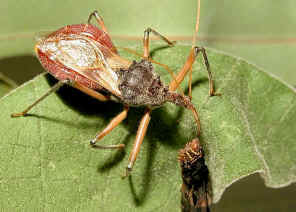|
|
Insect's Mouth
- There are the large variations among the mouths of different insects. The shape is much depend on the mouths’ function.

- Some insects’ mouth is for biting. Some have tube-like mouth to suck blood or plants juice. Most moths and butterflies have tube-like mouth so that they can reach deep into the flowers and suck the nectar. Some adult insects do not eat, like some moths, basically they do not have functional mouths.
- Although there are so many different shapes, the insect mouth basically consists of there pairs of limbs. They are the jaws mandibles, the second jaws maxillas (with maxillary palp) and the lower lip labium (with labial palp). Together with the upper lip labrum, they form the mouth of the insects.
Biting mouth
- Biting mouth is the basic insect mouth structure. Many groups of insects have biting mouth, they include Dragonflies, Orthopteroid Insects, Lacewings and Beetles.
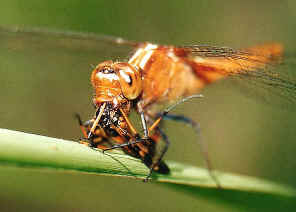

- Dragonflies, including damselflies, are predators. Their mouth-parts are adapted for predation, with wide gape and strong toothed mandibles. Larva mouth-parts like their adult but labium modified as extensible grasping organ.
- Orthopteroid Insects include cockroaches, Praying Mantids, Grasshoppers, Crickets, Katydids and Stick Insects. Most of them are herbivores although Praying Mantids are carnivores.


- Lacewings are the predators of other insects. Adults have the simple biting and chewing mouthparts. Larvae are diverse in form and habits, and their mouth-parts are vary. Larva of some species have conspicuous jaws.
- Beetle's mouth is also the standard biting mouth structure. Males in Lucanidae usually have large mandibles which they are used solely in combat with other males. Larval mouth-parts are quite variable.


- Typical Biting Mouth
- Let have a look at the biting mouth structure. The labrum is the upper lip of the insect mouth. The mandibles is a pair of toothed jaws for cutting and chewing. Inside the mouth is a pair of accessory jaws maxillas which normally not being seen outside. A pair of sensory organ maxillary palp is attached to them. The labium, is a pair of plates, fused together to form the lower lip of the mouth. It also has a pair of labial palp attached.
- For a biting mouth, the function of mandibles is to chop and chew the food into pieces. Some insects also use mandibles to cut the wood or dig the soil. The functions of the maxillas are to hold the food and assist the function of mandibles. The two pairs of maxillary palp and labial palp are to taste the food. Labium is function as the lower lip.
Sucking Mouth of Bugs
The bugs' mouth-parts are also known as stylets. It is the highly modified tube-like sucking mouth. These mouthparts are also known as a proboscis or rostrum for they are used for piercing the outer skin of plants or prey and sucking up the liquid food.
Bugs and mosquitoes have different type of tube-like mouths to suck blood or plants juice.
- The sucking mouth changed the bugs' lift style quite a lot. Cicada nymphs live underground, sucking juice from plants root. Some bugs life style evolved to the parasitic form to the plants, such as the aphids and scale insects.
- Some bugs are the predators of other insects, e.g. the Assassin Bug and the Predatory Stink Bug. They insert their mouth into the body of their preys.
- The sucking mouth-parts are modified from two pairs of stylets, the mandibular and maxillary stylets. The stylets fit inside the anterior groove of the segmented labium, also known as rostrum. Inside the stylets form two canals, the food canal and the salivary canal. The labium functions as the protective sheath, it covers around and along the whole length of stylets. Labium also helps as guiding tube during penetration. At the tip of stylets, it is usually barbed.
-
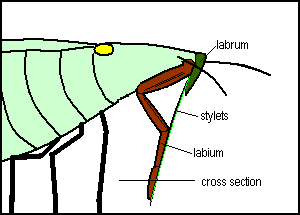

- Bug's sucking mouth-parts
- When feeding, only the stylets penetrate into the plant or prey tissue. Labium may bend or shorten to allow stylets penetration. There is the strong sucking pump muscle in the bug's triangular head. It pumps the salivary into the host via the salivary canal and suck up digested liquid via the food canal.
- There is the small and triangular labrum covering the stylets and labium at the base. When not feeding, the labrum, stylets and labium hold flat under the head and abdomen between legs.
- Please also visit our web page discussed on evolution of bug's sucking mouth.
Piercing mouth of Flies and Mosquitoes
- Mouthparts of adult fly and mosquito are modified for sucking
or sponging up fluids. Some of them may also be adapted for piercing.

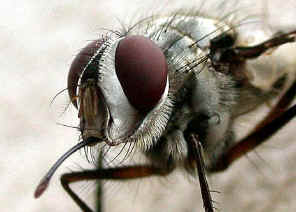
- Bugs and mosquitoes have different type of tube-like mouths to suck blood or plants juice.
Tubular mouth of Moths and Butterflies

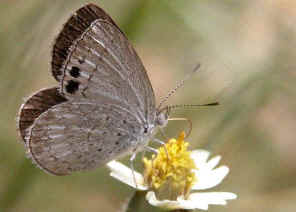
- Most moths and butterflies have tube-like mouth so that they can reach deep into the flowers and suck the nectar.
- For those sucking mouth, the tube is formed by the
modification of either one or both of the three pairs of limbs.
Mouth of Bees, Wasps and Ants
- Mouthparts of Bees, Wasps and Ants are modified as tools and weapons. They use them for cutting, carrying and building.


- Ants' mouth is also used for attacking enemy.
- Reference:
- 1. Insects of Australia, CSIRO, Division of Entomology, Melbourne University Press, 2nd Edition 1991, pp 7, 294.
- 2. The Australian dragonflies, J.A.L.Watson, G. Theischinger, H.M. Abbey, CSIRO 1991, pp 56.
- 3. Animals Without Backbones, Ralph Buchsbaum, Pelican / Penguin
Books,1968, pp 304.
- 4. Insects of Australia, George Hangay & Pavel German, Reed New Holland, 2000, pp 18.
- Back to Top
